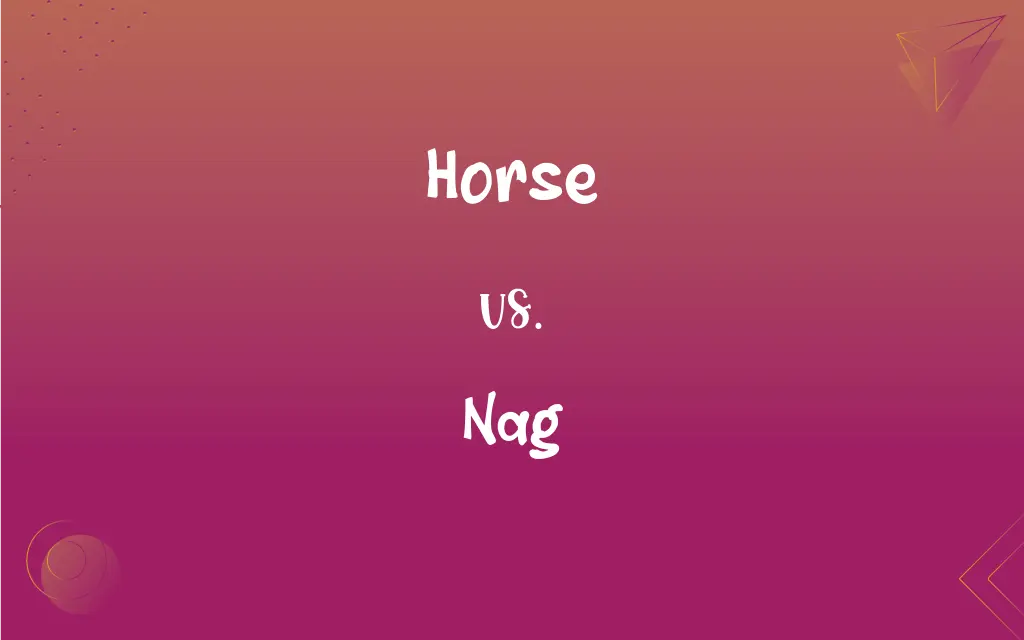Horse vs. Nag: What's the Difference?
By Aimie Carlson & Janet White || Updated on March 4, 2024
A horse is a large, domesticated mammal known for its speed, strength, and grace, widely used for riding, racing, and work. A nag, on the other hand, refers to an old or worn-out horse, often considered to be of inferior quality or in poor health.

Key Differences
Horses represent a broad category of equine animals, encompassing various breeds with diverse characteristics suited for multiple purposes, including sports, agriculture, and leisure activities. They are admired for their power, beauty, and versatility, playing significant roles in human history and culture. Nags are specifically identified as horses that are no longer in their prime, either due to age, health issues, or continuous hard labor, leading to diminished physical condition and performance. The term "nag" is often used pejoratively to describe a horse that is not considered desirable for serious work or riding, implying a lower value and utility.
The distinction between a horse and a nag is primarily based on condition and usefulness rather than breed or lineage. A horse might be referred to as a nag if it has been subjected to poor care, excessive work, or if it has simply aged to the point where its vitality has significantly decreased. This classification is subjective and can vary based on individual perspectives and the specific context in which the horse is used.
Conservation and welfare efforts for horses aim to prevent them from becoming nags by promoting responsible ownership, proper care, and retirement plans for older or working horses. These initiatives strive to ensure that horses can live out their lives in comfort and dignity, whether they continue to work in a reduced capacity or enjoy a well-deserved retirement.
Despite the negative connotation associated with nags, they can still play a meaningful role in the lives of those who care for them, offering companionship and the opportunity for leisurely activities. The relationship between humans and horses, regardless of the horse's condition, reflects a deep bond that has developed over thousands of years.
Comparison Chart
Definition
A large, domesticated mammal bred for various purposes including riding, racing, and work.
An old or worn-out horse, often considered to be of inferior quality.
ADVERTISEMENT
Use
Wide range of activities including sports, agriculture, and leisure.
Limited to less demanding roles due to diminished condition.
Condition
Can vary widely, generally healthy and well-cared for.
Typically in poor health or condition, often due to age or overwork.
Value
Depends on breed, training, and condition, but generally high.
Considered lower value due to decreased utility and performance.
Welfare Efforts
Focused on providing proper care, nutrition, and suitable work to maintain health.
Aimed at ensuring comfort and dignity in retirement or lighter duties.
Horse and Nag Definitions
Horse
A trusted companion in leisure riding.
She enjoyed peaceful afternoons riding her horse through the countryside.
ADVERTISEMENT
Nag
An old horse past its prime.
The gentle nag enjoyed leisurely walks around the pasture.
Horse
A majestic creature in parades and ceremonies.
The beautifully adorned horses added grandeur to the festival.
Nag
Requires special care and attention.
The aging nag required extra veterinary care to maintain its health.
Horse
A versatile animal used in equestrian sports.
The racehorse sprinted towards the finish line with remarkable speed.
Nag
Often associated with lower value.
The nag was sold for a fraction of what a younger horse might fetch.
Horse
A powerful worker in agriculture.
The farm's horses were essential for plowing the fields each spring.
Nag
Can still offer companionship.
The old nag became a beloved pet for the family's children.
Horse
Any of various equine mammals, such as the wild Asian species Przewalski's horse or certain extinct forms related ancestrally to the modern horse.
Nag
A horse with limited performance ability.
Despite being a nag, the old horse still loved to be ridden gently on sunny days.
Horse
A frame or device, usually with four legs, used for supporting or holding.
Nag
To annoy by constant scolding, complaining, or urging.
Horse
(Sports) A vaulting horse.
Nag
To torment persistently, as with anxiety or pain.
Horse
Often horses Horsepower
A muscle car with 400 horses under the hood.
Nag
To scold, complain, or find fault constantly
Nagging at the children.
Horse
Mounted soldiers; cavalry
A squadron of horse.
Nag
To be a constant source of anxiety or annoyance
The half-remembered quotation nagged at my mind.
Horse
A symbol of elegance and grace.
The horse's graceful movements captivated every observer at the show.
Nag
One who nags.
FAQs
What makes a horse a nag?
A horse becomes a nag due to age, health deterioration, or the effects of hard labor, leading to a decline in its physical condition and performance.
How can the welfare of a nag be ensured?
Ensuring the welfare of a nag involves providing proper nutrition, veterinary care, and a comfortable environment that suits its reduced capacity for work.
How do perceptions of nags differ across cultures?
Perceptions of nags vary, with some cultures valuing the wisdom and calm demeanor of older horses, while others may focus more on the animal's diminished utility.
Do nags play a role in therapy or educational programs?
Yes, nags can play a role in therapy and educational programs, offering opportunities for learning and emotional support through gentle interaction.
What are common misconceptions about nags?
Common misconceptions include that nags are useless or that all old horses are nags, ignoring their potential for companionship and light activity.
Are there specific breeds more likely to become nags?
No specific breeds are more likely to become nags; the condition is more closely related to individual health, care, and the amount of work the horse has done throughout its life.
Is the term "nag" used officially in the equine industry?
The term "nag" is more colloquial and pejorative, not commonly used in professional or official equine industry contexts.
What should be considered when adopting or purchasing a nag?
When adopting or purchasing a nag, consider its health, the care it will require, and whether you can provide a suitable environment for its needs.
What are the signs that a horse might be becoming a nag?
Signs include noticeable decline in performance, increased health issues, loss of condition, and reduced interest or ability in activities they once enjoyed.
Can a nag still be ridden?
Yes, a nag can still be ridden, but it is suited for light, leisurely riding rather than competitive or strenuous activities.
What are the benefits of keeping a nag?
Benefits include the companionship and joy that older horses can provide, the satisfaction of offering them a dignified retirement, and the opportunity for people, especially children, to learn about caring for older animals.
How can someone transition a working horse to a comfortable retirement?
Transitioning a working horse to retirement involves adjusting its diet, exercise, and health care regimen to suit its changing needs and ensuring it has a safe, comfortable environment.
What is the lifespan of a horse compared to when it might become considered a nag?
Horses can live up to 25-30 years or more, but a horse may be considered a nag when it shows significant signs of aging or wear, typically in its late teens to early twenties, depending on its health and workload.
Can nags be rehabilitated to become more active again?
While some nags may see improvements in their condition with proper care and rehabilitation, their ability to return to previous levels of activity is limited by age and health.
What role do rescue organizations play in the welfare of nags?
Rescue organizations play a crucial role in providing care, rehabilitation, and sanctuary for nags that have been neglected, abused, or are in need of a permanent home.
Can nags participate in competitive events?
While nags are generally not suitable for competitive events due to their diminished condition, they may participate in low-impact, non-competitive activities tailored to their abilities.
What legal protections exist for nags?
Legal protections vary by region but may include laws and regulations regarding animal welfare, which mandate proper care, prohibit neglect and abuse, and ensure humane treatment of all horses, including nags.
What ethical considerations come with owning or caring for a nag?
Ethical considerations include ensuring the horse's quality of life is maintained, providing appropriate medical care, and making humane decisions regarding the horse's health and end-of-life care.
How does the care of a nag differ from that of a younger horse?
Nags often require more attentive care, including specialized diets, regular veterinary checkups, and modifications to their living environment to ensure their comfort and health.
How can communities support the welfare of nags?
Communities can support the welfare of nags through donations to equine rescue organizations, volunteering at sanctuaries, and raising awareness about the needs and proper care of older horses.
About Author
Written by
Aimie CarlsonAimie Carlson, holding a master's degree in English literature, is a fervent English language enthusiast. She lends her writing talents to Difference Wiki, a prominent website that specializes in comparisons, offering readers insightful analyses that both captivate and inform.
Co-written by
Janet WhiteJanet White has been an esteemed writer and blogger for Difference Wiki. Holding a Master's degree in Science and Medical Journalism from the prestigious Boston University, she has consistently demonstrated her expertise and passion for her field. When she's not immersed in her work, Janet relishes her time exercising, delving into a good book, and cherishing moments with friends and family.































































